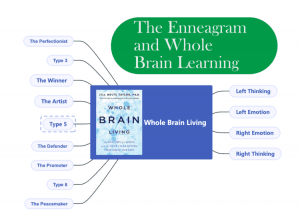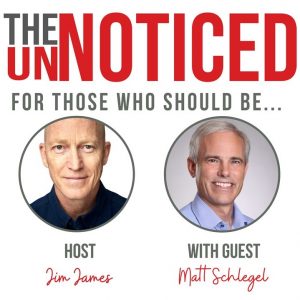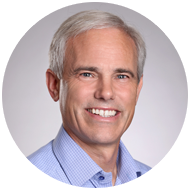
In preparation for this week’s Enneagram workshop, I am re-reading Jill Bolte Taylor’s book, Whole Brain Living. You may recall Bolte Taylor’s famous 2008 Ted Talk (https://www.ted.com/talks/jill_bolte_taylor_my_stroke_of_insight) in which she recalled her experience her brain processing differently during a stroke. She experienced her perception change. She experienced her personality change. As a Harvard-trained brain scientist and researcher, she recognized which parts of her brain were losing dominance and which parts were becoming dominant.
In his book, Personality and the Brain, Peter Savich maps left- and right-thinking brain and left- and right-emotional brain to the nine points of the Enneagram. As I read Bolte Taylor’s experiences, I can’t help but appreciate how her descriptions match up to behaviors described by the Enneagram.
The hemorrhage occurred on the left side of her brain and shut down left-thinking and left-emotional brain function. She became purely right-thinking and right-emotional dominant.
As I read her descriptions, I glean that before the stroke she was left-thinking brain dominant with a strong right-emotional brain. This maps to either Type 3 or Type 8. With all of her accomplishments, I can’t help but think she was likely a Type 3 before the stroke.
For instance, on page 29 she writes, “When I salvaged the functions of my left-brain thinking module, with them came the goal-driven, well-organized, methodical, controlling character who had dominated my pre-stroke life.” She seems to be describing Type 3 behaviors here.
On page 25 she says, “Remember that Blackberry? It used to make my right brain moan.” Clearly she already had ready access to her right-emotional brain, which could also be Type 3 in Savich’s model. Type 3s also have access to the left-emotional brain, so she would have recognized a loss of that function during the stroke event.
She goes on to write on page 29, “I will admit that I truly enjoyed not having any of the pain from my past in my left-brain emotional module anymore.” Enneagram Type 3s suppress their emotions. In the period after the stroke and before recovery, she was relieved from the work of suppressing emotions. When her emotions came back, she was reminded of the work she needed to do to suppress them.
She enjoyed the experience of right-thinking brain dominance. Curiously, the path of integration for Type 3 is towards Type 6, which is right-thinking brain dominant. What Bolte Taylor describes here is an Enneagram Type 3 moving along the path of integration towards Type 6 behaviors and exercising those parts of the brain.
Finally, when I watched the Ted Talk, I was impressed by the emotionally delivery of her experience. Enneagram Type 3s have difficulty expressing emotion. Enneagram Type 3s working in academic settings dominated by the emotionless Enneagram Type 5 dynamic would have just that much more difficulty expressing emotions. Having gone through the experience of being relieved of left-emotional brain function and knowing how to better access right-emotional brain function seems to have given Bolte Taylor the ability to genuinely access and convey emotions in front of an audience. The operating word is “genuine.”
I am excited as we continue to learn more about the Enneagram-brain connection.

